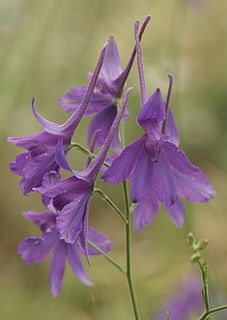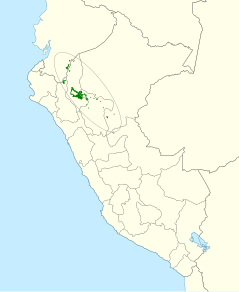
Mondovì is a town and comune (township) in Piedmont, northern Italy, about 80 kilometres (50 mi) from Turin. The area around it is known as the Monregalese.

Osmunda regalis, or royal fern, is a species of deciduous fern, native to Europe, Africa and Asia, growing in woodland bogs and on the banks of streams. The species is sometimes known as flowering fern due to the appearance of its fertile fronds.

Citheronia regalis, the regal moth or royal walnut moth, is a North American moth in the family Saturniidae. The caterpillars are called hickory horned devils. The adult (imago) has a wingspan of 3.75-6.1 in (9.5-15.5 cm). The species was first described by Johan Christian Fabricius in 1793.

Consolida regalis, known as forking larkspur, rocket-larkspur, and field larkspur, is an annual herbaceous plant belonging to the genus Consolida of the buttercup family (Ranunculaceae).

The royal sunangel is a species of hummingbird. It is endemic to subtropical elfin forests and shrubs in the Andes of northern Peru and adjacent south-eastern Ecuador. It is endangered due to habitat loss. It is strongly sexually dichromatic, and while females resemble other female sunangels, males are unique with their iridescent dark blue plumage.

Edmontosaurus regalis is a species of comb-crested hadrosaurid (duck-billed) dinosaur. Fossils of E. regalis have been found in rocks of western North America that date from the late Campanian stage of the Cretaceous Period 73 million years ago.

The cero, also known as the pintado, kingfish, cero mackerel, or painted mackerel, is a ray-finned bony fish in the family Scombridae, better known as the mackerel family. More specifically, this fish is a member of the tribe Scomberomorini, the Spanish mackerels, and is the type species of the genus Scomberomorus. It is similar in appearance and coloration to the Atlantic Spanish mackerel, Scomberomorus maculatus, except the cero has a longitudinal stripe in addition to the spots of the Atlantic Spanish mackerel.

Poecilotheria regalis is a species of arboreal tarantula is found in the whole of south Asia. The common name for this spider is Indian ornamental tree spider, or simply Indian ornamental. It is one of the most popular arboreal tarantulas for amateur collectors. Their leg span sometimes exceeds 7 inches (18 cm).
"Release" is the seventeenth episode of the ninth season of the American science fiction television series The X-Files. The episode originally aired on the Fox network on May 5, 2002. The teleplay for the episode was written by David Amann, from a story by John Shiban and Amann, and was directed by Kim Manners. The episode helps to explore one of the show's story arc involving John Doggett finding the truth behind his son's murder. The episode earned a Nielsen rating of 5.1, being watched by 5.38 million households, and 7.8 million viewers in its initial broadcast. The episode received largely positive reviews from critics.

Amanita regalis, commonly known as the royal fly agaric or the king of Sweden Amanita, is a species of fungus in the Amanitaceae family. Common in Scandinavian countries, it is also found in eastern and northern Europe. In North America, its distribution is restricted to Alaska. The fruit bodies of the fungus somewhat resemble the fly agaric, and it was formerly regarded as a variety of this species. A. regalis differs from it in being larger, with a liver-brown cap bearing numerous scabs, and in having a stem which is yellow-ochre at the base, with patches or rings of patches. Chemical analysis has shown that this species contains muscimol, the same psychoactive compound found in A. muscaria.

Osmunda spectabilis or (American) royal fern is a species of fern once thought to be the same as Osmunda regalis, but recent genetic studies have shown it to be a separate species.

Biston regalis is a moth of the family Geometridae. It is found in China, Taiwan, Russia, Japan, North Korea, South Korea, India, Nepal, the Philippines, Pakistan and the United States.

Zographus regalis is a species of beetle belonging to the family Cerambycidae.
Synalpheus regalis is a species of snapping shrimp that commonly live in sponges in the coral reefs along the tropical West Atlantic. They form a prominent component of the diverse marine cryptofauna of the region. For the span of their entire lives, they live in the internal canals of the host sponge, using it as a food resource and shelter. It has been shown that colonies contain over 300 individuals, but only one reproductive female. Also, larger colony members, most of which apparently never breed, defend the colony against heterospecific intruders. This evidence points towards the first case of eusociality in a marine animal.

The Liber Regalis is an English medieval illuminated manuscript which was, most likely, compiled in 1382 to provide details for the coronation service for Richard II's consort, Anne of Bohemia. Other sources suggest that it may have been compiled in 1308 for the coronation of Edward II. The Liber Regalis contains the ordo (order) for the following events: the coronation of a king, a king and queen and a queen alone, and details regarding the funeral of a king; each liturgy opens with a full-page illustration depicting the event.

Sybra is a genus of beetles in the family Cerambycidae, containing the following species:

Sybra umbratica is a species of beetle in the family Cerambycidae. It was described by Pascoe in 1865.

Sybra ordinata is a species of beetle in the family Cerambycidae. It was described by Bates in 1873.
Martin Regáli is a Slovak professional footballer who plays as a forward who plays for MFK Ružomberok.

Ugrunaaluk is a dubious genus of saurolophine hadrosaurid which was found in the Arctic of Alaska. It contains the species Ugrunaaluk kuukpikensis. Its name is derived from the Inupiat words for 'ancient grazer'.

















